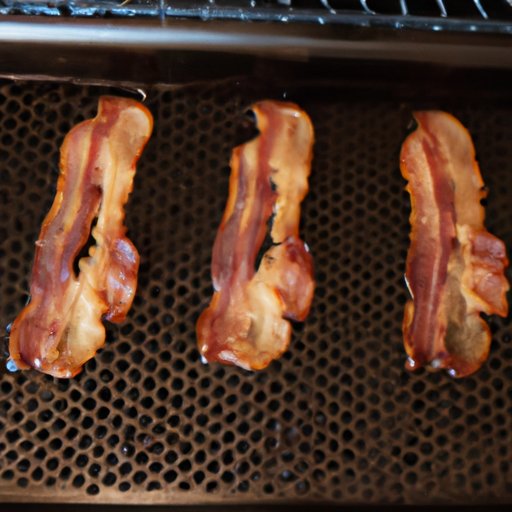
I. Introduction
Baking bacon can be a challenge, especially for beginners. Frying bacon in a pan can be messy, create a lot of smoke in your kitchen, and cause nasty burns. However, when you learn how to bake bacon in the oven, you’ll discover that it is much more convenient, safe, and produces crispy, delicious bacon.
This article aims to provide a comprehensive guide for baking your bacon to perfection with ease. Let’s dive in and learn how you can bake bacon in the oven and simplify your life in the kitchen.
II. Benefits of Baking Bacon in the Oven
Baking bacon in the oven has several benefits, making it a preferred method of cooking bacon. First and foremost, baking allows the bacon to cook evenly without curling up, resulting in crispy bacon. Secondly, since baking bacon requires little to no oil, it ends up being healthier than frying in a pan. Thirdly, since it’s convenient to bake bacon, you can easily cook large batches at once, making it perfect for breakfast or brunch get-togethers.
Comparing baking bacon in the oven to traditional frying, you will discover that baking is faster, less messy, and less challenging than frying bacon in a pan.
III. Choosing the Right Tools and Equipment
Before you embark on baking your bacon, it’s crucial to gather the right tools. You’ll need a baking sheet, a wire rack, and some aluminum foil or parchment paper. The baking sheet should be large enough to accommodate all the bacon in a single layer so that it cooks evenly. The wire rack is essential as it prevents the bacon from sitting in its grease, resulting in crispy and healthier bacon. The foil or parchment paper is optional but helps with clean-up.
Using the right tools will not only make your cooking easier but will ensure that the bacon is cooked to perfection.
IV. Preparing the Bacon for Baking
When preparing bacon for baking, it’s essential to consider the type of bacon you are using. You can use thick or thin cuts, depending on your preference. Thick cut bacon will take longer to cook, so make sure to adjust the cooking time accordingly. Also, it’s essential to remove the bacon from the fridge for some time before cooking to allow it to come to room temperature.
When it comes to seasoning the bacon, you can opt to use black pepper or any other seasoning of your choice. Make sure not to over-season the bacon, or it will overpower the taste of the bacon. Additionally, when layering the bacon in the baking sheet, ensure that the bacon doesn’t overlap, as it will affect its even cooking. You can use a wire rack to help with the layering and ensure that the bacon doesn’t stick to the baking sheet.
V. Baking Time and Temperature
The recommended temperature for baking bacon is 400°F (205°C), and it usually takes about 15 to 20 minutes to cook depending on the thickness of the bacon and the desired crispiness. It’s crucial to monitor the bacon while baking to ensure it doesn’t overcook or undercook. You can use a meat thermometer to check the temperature of the bacon to ensure it’s cooked to your desired level.
If you like your bacon crispy or slightly chewy, you can adjust the cooking time. For chewy bacon, reduce the temperature to 375°F (190°C) and add an extra 2 to 3 minutes of cooking time. For crispy bacon, you can increase the temperature to 425°F (218°C) but reduce the cooking time to about 10 to 12 minutes.
VI. Tips for Serving
Once you have baked the bacon to perfection, you can get creative with your toppings. Some of the popular toppings include maple syrup, hot sauce, or fresh fruit. You can also serve the bacon as a side dish or as a topping on your favorite breakfast sandwich or salad. When storing leftover bacon, it’s crucial to cool it first before refrigerating in an airtight container or freezer bag. To reheat, you can use the oven, microwave, or skillet.
VII. Conclusion
Baking bacon in the oven is an easy and foolproof way of cooking crispy bacon. It’s faster, less messy, and more convenient than traditional pan-frying bacon. To bake perfect bacon, you’ll need to choose the right tools and materials, prepare the bacon properly, and use the recommended temperature and cooking time. Don’t be afraid to experiment with different types of bacon, seasoning, and cooking times to find your perfect bacon.





